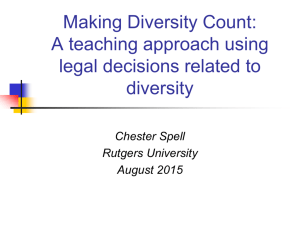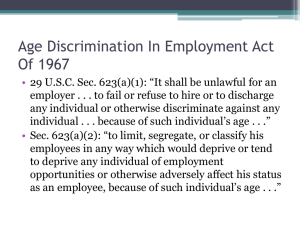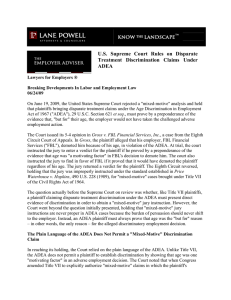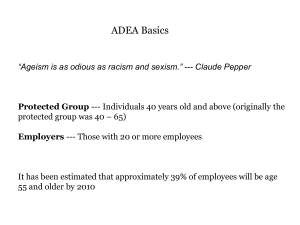Age Discrimination Summary
advertisement
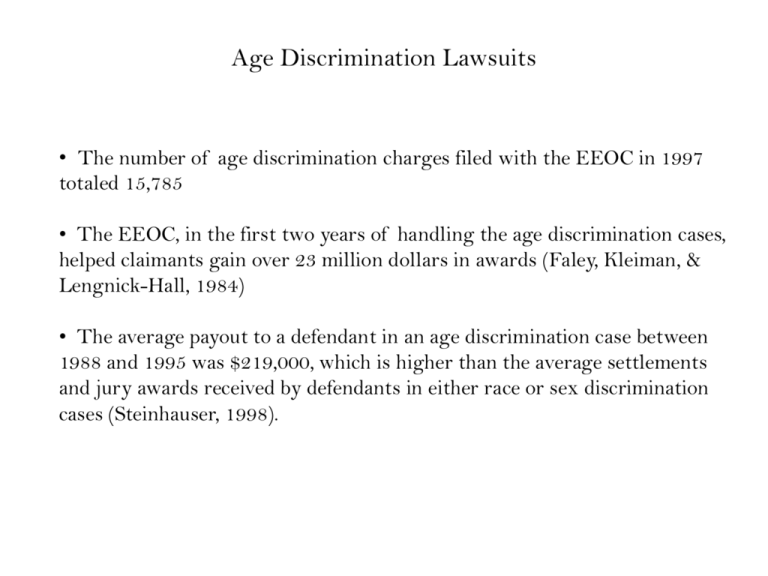
Age Discrimination Lawsuits • The number of age discrimination charges filed with the EEOC in 1997 totaled 15,785 • The EEOC, in the first two years of handling the age discrimination cases, helped claimants gain over 23 million dollars in awards (Faley, Kleiman, & Lengnick-Hall, 1984) • The average payout to a defendant in an age discrimination case between 1988 and 1995 was $219,000, which is higher than the average settlements and jury awards received by defendants in either race or sex discrimination cases (Steinhauser, 1998). Age and Job Performance • Cleveland and Landy (1983) reviewed the gerontology literature and found chronological age not to be a valid predictor of performance for a specific individual in a particular job • Evidence from a meta-analysis (Waldman & Avolio, 1986) found no significant differences between age groups in objective work performance measures. Rather, the analysis indicated that older workers received lower performance scores when subjective supervisory ratings were used • Laczko and Philipson (1991) reviewed studies of age effects on job performance and learning ability. It was found that older workers are as productive as younger workers, they are almost as capable of learning (despite less formal education), and have an energy, flexibility, and willingness to learn BFOQ Defense 1) “That the BFOQ is reasonably necessary to the essence of the business” and 2) “That it has reasonable cause, i.e., a factual basis for believing that all or substantially all persons within the protected age group would be unable to perform safely and efficiently the duties of the job involved, or whether it is impossible or impractical to deal with persons in the protected age group on an individual basis” (Usery v. Tamiami Trail Tours, Inc. 1976, pg. 1241-1242). Griggs-Albemarle (Title VII) Phase 1: Statistical evidence of an identified employment practice that disproportionately excludes protected group members Phase 2: Proof that the challenged practice is job related and consistent with business necessity Phase 3: Proof there is an equally valid, job-related practice with less or no adverse impact Smith v. City of Jackson (ADEA) Phase 1: Statistical evidence of an identified employment practice that disproportionately excludes protected group members Phase 2: Proof that the challenged practice is supported by a Reasonable Factor Other Than Age (RFOA) Phase 3: Proof that the factor cited is unreasonable or not the true reason for the employment practice Role of statistics in proving a prima facie case of age discrimination • From Walker v. Pettit Construction Co. “statistical proof [in ADEA cases] may be of some probative value but it is not of conclusive effect” (1979, p. 306) • From Kelley v. American Standard, Inc.: “statistical evidence alone may be used to establish discriminatory impact on older persons” (1981, p. 78) • Generally, larger statistical differences for usually required in ADEA cases as compared to those filed under Title VII. FOA Defense (Reasonable Factors Other Than Age) [e.g., that a personnel decision was “reasonable” and based on some factor (s) other than age] • Company needs only to articulate clearly the specific nature of the FOA • Two broad FOA categories (economic-based and non-economic based) Role of Performance Appraisal Validity in ADEA Cases vs. Title VII criteria: Stringfellow v. Monsanto, Co. 1970. Performance evaluations resulted in a disproportionate number of older workers being discharged. Key issue is whether age was a determining factor in the evaluations • Mastie v. Great Lakes Steel Corp. 1976. Performance appraisals challenged due to improper preparation and lack of knowledge about employees. “The question is not whether the evaluations of the affected employees were completely accurate, but rather, whether a thorough evaluation of all employees concerned was genuinely and honestly attempted” (p. 966). That is, the accuracy of the appraisals was not considered to be a requirement under the ADEA. Economic Factors (e.g., reduction in force; RIF) • Cost and not age must be the determining factor in the decision • Plaintiff burden to show that “...the employment decision is based in whole or in part upon age, or if one of the reasons for the employment decision was age, the plaintiff is entitled to damages under the ADEA” (Geller v. Markham, 1980, p. 1219). “Even had age not been considered, defendant would not have hired plaintiff because of other legitimate business factors which were unrelated to Plaintiff ’s age (Moyer v. Elder-Beerman Stores Corp. (1980, p. 846) Safety Concerns • Where safety issues of 3rd parties exist (regarding a BFOQ defense) the company: “Must be afforded substantial discretion in selecting specific age-related standards which, if they err at all, should be on the side of preservation of life and limb” (Tamiami, p. 1243) • An employer’s burden of showing a BFOQ is “inversely proportional to the degree and unavoidability of the risk to the public or fellow employees inherent in the requirements and duties of a particular job” (Aarin v. Davis, p. 1572). Kimel v. Florida Board of Regents (2000) Amendment XI (1798) The judicial power of the United States shall not be construed to extend to any suit in law or equity, commenced or prosecuted against one of the United States by citizens of another state, or by citizens or subjects of any foreign state. Sovereign State Immunity Amendment XIV (1868) Section 1. All persons born or naturalized in the United States, and subject to the jurisdiction thereof, are citizens of the United States and of the state wherein they reside. No state shall make or enforce any law which shall abridge the privileges or immunities of citizens of the United States; nor shall any state deprive any person of life, liberty, or property, without due process of law; nor deny to any person within its jurisdiction the equal protection of the laws. Equal Protection Clause Section 5. The Congress shall have power to enforce, by appropriate legislation, the provisions of this article In 1974, Congress exercised its authority under Section 5 of the 14th Amendment to extend coverage of the Age Discrimination in Employment Act of 1967 (or ADEA) to state entities. Levels of scrutiny [state requirement when expressing authority over its citizens] Rational Basis -- There must be a reasonable relationship between a law and a legitimate governmental objective Moderate Scrutiny -- There must be an important government objective and a solution substantially related to that objective Strict Scrutiny -- There must be a compelling government interest for a law and a solution narrowly tailored to that interest Title VII classes have long been deemed suspect, meaning that under the 14th Amendment heightened scrutiny applies to state laws for discrimination based on race, color, religion, sex, and national origin. Under current Supreme Court precedents, moderate scrutiny applies to gender discrimination and strict scrutiny to discrimination based on race, color, religion, and national origin. Justice O'Connor struck down the application of the ADEA to the states based on the "congruence and proportionality" test, itself a measure of heightened scrutiny when Section 5 of the 14th Amendment authority is appropriately expressed. Accordingly, Congress must: (a) Provide evidence of past purposeful discrimination, and (b) apply a proportional remedy. On the issue of congruence , O'Connor ruled that: Older persons ...unlike those who suffer discrimination on the basis of race or gender, have not been subjected to a "history of purposeful unequal treatment"...Old age does not define a discrete and insular minority because all persons, if they live out their normal life spans, will experience it. On the issue of proportionality, O'Connor ruled that the "substantive requirements that the ADEA imposes on state and local governments are disproportionate to any unconstitutional conduct that conceivably could be targeted by the Act." Bottom Line --• The Kimel ruling means there is no federal remedy for individuous age-based claims, (e.g., failure to hire, promote, or train, harassment, discharge. Such claims must rest on applicable state laws. • Second, any class action challenge to a state law, policy, or custom would have to be deemed irrational in order to be struck down Reeves v. Sanderson Plumbing Products, Inc Reeves was fired for poor performance reasons (company position) Suit filed alleging that this explanation was a pretext for age discrimination • Formed a prima facie case based on the McDonnell Douglas criteria • Provided evidence that showed the company’s legitimate reasons for termination were false (lower court said that this did not mean that Reeves has presented sufficient evidence that he had been fired because of his age) • Recipient of derogatory age-based remarks from his supervisor (lower court said these comments were not made with specific reference to the decision to terminate Reeves) Use of indirect evidence - Enough to infer the fact of intentional discrimination “… a plaintiff ’s prima facie case. Combined with sufficient evidence to find that the employer’s asserted justification is false, may permit the trier of fact to conclude that the employer unlawfully discriminated.”





